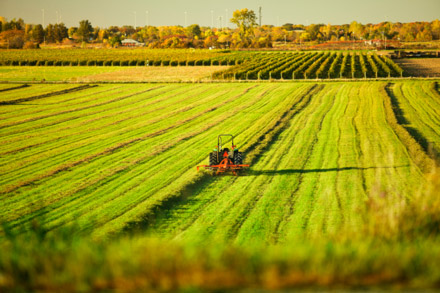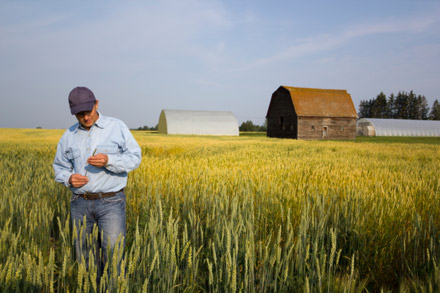USDA & Advanced Biofuels Strengthening Agriculture & Military Links
At first glance it would seem that a Navy Aviation Boatswain’s Mate doing his job inspecting JP-5 jet fuel on an aircraft carrier and a farmer producing her wheat crop in Montana would have little in common. But, there is more to this connection than meets the eye. Both contribute to the security of the country at home and abroad by doing what they do best. Both represent portions of the Nation’s workforce that make up less than two percent of the population. And, both are becoming interlinked by the need for domestically produced ready-to-use biofuels, which will be made from plant-based materials harvested from farms, forests and other rural lands.
However, for this partnership to become a sustainable reality that reduces dependence on foreign sources of oil, the creativity and skills of people in private business, government and universities must be unleashed. New ways must be found to overcome challenges to producing abundant and cost-competitive biofuels, which power aircraft, ships and ground vehicles. So, what can be done to create sustainable supply chains of aviation and other biofuels suitable for military and commercial uses?
Starting with the End in Mind
A drop-in biofuel supply chain for the military and commercial aviation begins at the end with the end user’s specifications for a needed fuel. Without a clear understanding of the complete supply chain by all participants – from the feedstock producer to the biorefinery that produces a tested and certified fuel to the purchaser of the fuel – the likelihood is low for achieving success in reaching cost-target and utilization goals for biofuels made from plant-based feedstocks.
Coordinated supply chains need to be formed among a diversity of participants and stakeholders who work in an interdependent fashion to help ensure transaction costs are minimized so biofuel prices are competitive with petroleum-based fuels. This will require the core competencies and resources of each supply chain participant be utilized in ways that ensure optimal results with the greatest returns on investments. Sustainable supply chains are those where all component participants are productive, profitable and make their contributions in ways that provide for good stewardship of natural and human resources. If any one portion of the supply chain is unsustainable, then all portions will, collectively, collapse in the long run.
A Clear Goal & Commitment to Partnerships
Executive and legislative actions have put into motion significant Federal government responses designed to advance the development and production of domestic biofuels. On May 5, 2009, a Presidential memorandum, Biofuels and Rural Economic Development, instructed the Secretary of the Department of Agriculture (USDA), Secretary of the Department of Energy (DOE) and Administrator of the Environmental Protection Agency (EPA) to form the Biofuels Interagency Working Group (IWG) and come up with a comprehensive plan to accelerate U.S. biofuels production.

© iStockphoto.com/iqoncept
This action was driven by the Energy Independence and Security Act of 2007 (EISA), which expanded the Renewable Fuel Standard 2 (RFS2) by requiring 36 billion gallons of biofuels be blended with U.S. transportation fuels by 2022. With conventional biofuels from corn grain ethanol capped by this legislation at 15 billion gallons, at least 21 billion gallons of biofuels derived from other bio-based materials are needed to meet the RFS2. The 15 billion gallons of corn grain-based ethanol have been nearly achieved in a remarkably short period of time. However, the development of the 21 billion gallons of advanced biofuels has been a greater challenge due to financial and technological barriers.
These are now the focus of accelerated research and commercialization efforts. It is this emerging advanced biofuel sector that is important to military and commercial aviation as ethanol is not suitable for a majority of these uses. For this reason, strategic partnerships have been established between the USDA, Department of Defense (DoD), Federal Aviation Administration (FAA), commercial air transportation industry and others to utilize the core competencies of government agencies and private industry to accelerate commercial production of advanced biofuels. In response to the need for drop-in aviation and marine fuels, agreements have been made that specifically support military and commercial air transportation.
A Memorandum of Understanding (MOU) was established on January 21, 2010, between USDA and the Department of Navy (Navy) to encourage development of advanced biofuels and other renewable energy systems. The Navy and USDA are now sharing technical, program management and financial expertise to help build a strategic energy future, which will result in a more effective fighting force while also helping to reduce market uncertainties and environmental impacts from using conventional fuels.
On July 21, 2010, the Farm to Fly Initiative was announced – a USDA partnership with Boeing and the Air Transportation Association (ATA) to accelerate availability of sustainable aviation biofuels, to increase domestic energy security and to establish regional supply chains, which support rural economic development. By working together, the partners are pursuing regional opportunities and programs to find ways to meet mutual goals and to bring about commercial production of aviation biofuels.
Another MOU was signed on October 21, 2010, between USDA and FAA to evaluate the readiness of different kinds of feedstocks, which can be processed by biorefineries to produce aviation biofuels. The aviation industry and military had demonstrated that small quantities of certain aviation biofuels could be successfully used in test flights, but there was no short-term prospect of having sufficient feedstock supplies to make commercial-scale amounts. By partnering with USDA, the aviation industry proposed a way to identify and to repair disconnects between biofuel technical readiness and its commercial use. As a result, an assessment framework called the “Feedstock Readiness Level” (FSRL) tool has been developed.
On August 16, 2011, President Obama announced an investment of up to $510 million during the next three years through a Navy, DOE and USDA joint arrangement in partnership with the private sector to produce drop-in aviation and marine biofuels. This new initiative under the Title III Defense Production Act (DPA) recognizes the lack of U.S. strategic manufacturing capability for drop-in biofuels and will help industry accelerate production of jet and diesel biofuels for military and commercial aviation. The DPA funding will be used to construct or to retrofit several commercial drop-in biofuels plants and refineries. In recognition that the Federal government alone cannot produce biofuels, the departments and agencies are partnering with the private sector.
USDA Acts to Support the Effort
In addition to working in partnership on specific efforts, the USDA has a broad commitment of resources, which continues to support development of drop-in biofuels. The President’s Biofuels Interagency Working Group’s Growing America’s Fuels Report has been followed to ensure that USDA government agency efforts are coordinated, with USDA having lead responsibility and other for feedstock development, feedstock production systems, deployment of commercial facilities, development of best practices and provision of technical assistance, and co-leadership for accomplishing these in a sustainable manner.
To help ensure the needed feedstocks for producing the next generation of military and aviation biofuels are available as industry expands, USDA developed a coordinated research, education and extension effort.

© iStockphoto.com/Pgiam
Five regional Biomass Research Centers were established utilizing nation-wide networks of USDA scientists and facilities managed by the Agricultural Research Service (ARS) and U.S. Forest Service Research and Development (FS). The Centers lead a national research effort to help develop sustainable biomass production systems, superior performing feedstocks and value-added co-products.
In complementary fashion, the National Institute of Food and Agriculture (NIFA) has offered competitive grants through their Coordinated Agricultural Projects (CAP) to support research and grower education. USDA Regional Biomass Research Centers and NIFA CAP projects have been designed to focus, to coordinate and to accelerate the science and technology needed to support sustainable deployment of superior-performing feedstocks and sustainable region-based agricultural and forest-based production systems for producing advanced biofuels.
Specific to the development of aviation biofuel feedstocks, ARS and FS researchers working through USDA Biomass Research Centers, land grant universities supported by NIFA formula funds and industry partners are determining the best ways to incorporate biofuel crops into existing farm and forest systems. On August 30, 2011, USDA awarded three CAP grants that directly support production of aviation biofuels from biomass. The Office of Naval Research (ONR) is also involved. It is supporting efforts to predict dependability of high quality feedstock supplies in Hawaii, as well as to determine where bioenergy crops for jet fuel can be produced on marginally productive and abandoned lands in the western U.S. so that biofuel crops won’t displace food crops.
Feedstock research is just one part of the USDA approach to helping develop region-based advanced biofuel supply chains. Multiple other USDA programs are available, which can directly help reduce the risks to feedstock producers and to instill confidence in the investment community all the way down the supply chain to the establishment of commercial biorefineries. The USDA Farm Service Agency (FSA) offers the Noninsured Crop Disaster Assistance Program (NAP) to reduce production risks faced by producers of biomass and other energy crops that are not insurable through normal commercial or USDA insurance tools. Crop insurance tools reduce financial losses when natural disasters cause catastrophic production losses or when producers cannot plant because of adverse weather.
The Conservation Loan (CL) program also provides farmers access to credit to establish approved conservation practices that reduce soil erosion, improve water quality and promote sustainable best practices. The FSA Biomass Crop Assistance Program (BCAP) is a source of financial assistance to growers and other supply chain participants who deliver biomass to conversion facilities producing biofuels, heat, power or biobased products. The USDA recently announced two new BCAP projects specifically targeted to the Western U.S. in support of oil seed feedstocks for use in making hydrotreated renewable jet (HRJ) fuel.
Federal support is also available to assist biorefinery development efforts from research concept through commercialization. The USDA Small Business Innovation Research (SBIR) grants administered through NIFA support pilot-scale research and demonstration efforts while the USDA agency Rural Development (RD) administers commercialization grants and the Business and Industry Guaranteed Loan Program under the USDA 2008 Farm Bill Energy Title. These can be used to finance scaled-commercial technologies from proven pilot-scaled demonstrations, and first-of-a-kind and multiple deployed full-scale commercial facilities. The DOE supports similar research, demonstration and commercial development programs through its Office of Science, Office of Energy Efficiency and Renewable Energy, and Office of Advanced Research Projects Agency – Energy.
The USDA research and commercialization programs mentioned above – along with those provided by other government agencies and industry – can be used to help establish links between feedstock supplies and new conversion technologies to accelerate commercial efforts by farmers, foresters, biorefinery operators and others involved in biofuel supply chains.

© iStockphoto.com/SimplyCreativePhotography
Biomass programs that lower risks can help build farmer receptivity to growing feedstocks because they will have assured markets for their products, just as programs have been created to help reduce investor uncertainty and build confidence for financing construction of new biorefineries.
The Scope of the Challenge
Expanding production of biomass and other dedicated biofuel feedstocks will affect virtually all aspects of existing agriculture and forestry – from domestic demand and exports of commodities to prices to land-use allocations among crops and timber already grown and new energy crops that will be needed. The agricultural lands required to annually produce feedstocks needed to meet their portion of the 21-billion gallons of advanced biofuels could exceed 24 million acres – an area approximately equal to corn and soybean production in Iowa. Also, USDA reports the investment required to build more than 500 new 40-million gallon biorefineries is approximately $160 billion. These are great challenges, but the goal is achievable.
All the needed biofuel feedstocks and biorefinery facilities will not appear overnight. Scaling-up will take time, and their potential impacts will not be as great for the first 30, 40 or 50 new facilities that are built, as with the next 300, 400 and beyond. Therefore, there is time to design and to manage the developing and expanding biofuels industry in ways that reduce disruption to existing land uses and markets – providing details to consider regarding potential trade-offs. So, what are the basics about feedstocks and other resources, which should be thoughtfully analyzed?
Develop Sustainable Feedstock Supplies
No vast tracts of unused or unproductive lands exist in the U.S., and most rural areas already serve many critical functions. Farms, ranches and forests produce high quality, nutritious, abundant and safe foods, as well as fiber and wood products, that are the basis of income for producers and their rural communities. Rural areas also provide significant ecosystems services – such as clean air and water, and wildlife habitat – and are a long-term repository for biodiversity. Since these lands will be the source of much of the new feedstocks needed for aviation and military biofuels, the challenge is how to best incorporate their production into existing farms and forests in a sustainable manner.
No one region or one kind of biofuel feedstock will be able to meet all needs. However, with the diversity of climates, soils and existing land uses across the country, ample options exist to provide the biomass needed to meet a significant portion of the Nation’s renewable energy needs while at the same time providing new economic opportunities for many rural communities. It is estimated that from 0.2 to 12 percent of total crop and pastureland production areas in any one region are needed to meet the requirements of RFS2. To develop sustainable high-performance biofuel supply chains, choices will need to be made for how best to use the regional resources available through an asset-based sustainable development approach.
Not all feedstocks are as productive as others, even when grown under optimal conditions in the regions where they grow best. Oil seed crops, such as Camelina, are already proven feedstocks for use in aviation fuels but are adapted to arid regions where cereals grow best. And, they have limited production potential.

© iStockphoto.com/shotbydave
Tropical grasses, such as Napiergrass or sugar cane, have much greater potential for producing greater volumes of biofuels per area of production but are limited to semitropical growing conditions in southeastern North America. Algae biomass holds great promise because potential for biofuel yield is greater than oil seed crops or tropical grasses, but sustained full-scale production has not yet been demonstrated. Therefore, limitations to performance of different feedstocks should be considered in context to where they grow best, the productivity of other feedstocks, other competing land uses and the human capital available, all at the same time. Because production of agricultural and forest-based feedstocks is dynamic – greatly influenced by climate and competing commodity markets and land uses – all biofuel supply chain participants need to understand the risks associated with feedstock production and the factors influencing readiness of feedstocks for use in commercial biofuel production.
To develop high-performance biofuel supply chains, which result in prices competitive with petroleum-based fuels, choices of conversion technologies and suitable feedstocks will need to be made in ways that optimize use of available local and regional resources to minimize transaction costs along the supply chain. By selecting a range of feedstocks that are adapted over a range of growing conditions across the country, a diversity of biofuel supply chains can emerge supported by many rural areas. This approach also encourages use of feedstocks best suited to different U.S. regions and takes advantage of the geographically diverse natural, business and workforce resources within the regions. It can be assumed that utilizing a diversity of feedstocks also reduces resource pressure on any one area and provides greater resilience to changing markets, drought, pests and other production risks.
Realizing a Renewable Fuel Future
It is not outside the range of possibilities that a Navy aviator looking down from 30,000 feet en route from Whidbey Island to Jacksonville could see Western forests free of diseased and dead trees that used to feed wildfires whipped by dry autumn winds. Or, he may see farmers’ alternating checkered squares of green-colored wheat and yellow-flowered oil seed fields across eastern Montana. Or, tens of thousands of acres of southeastern Great Plains rangelands may be visible, cleared from invasive eastern red cedar so cattle and bison can once again graze freely.
One day soon fields with 15-foot-tall energy grasses may weave among stands of longleaf pines growing in Mississippi, Alabama and the Florida panhandle. These will be the scenes across rural America, where farms and forests are the source of feedstocks used to produce the next generation of biofuels. By embracing change, innovative partnerships and advanced biofuels will help build a renewable energy economy, reduce energy consumption derived from imported fossil fuels and increase energy production from America’s abundant natural resources.

U.S. Navy photo by Kelly Schindler|An EA-6B Prowler from the “Salty Dogs” of Air Test and Evaluation Squadron 23 (VX-23) flies over Southern Maryland on a biofuel blend of JP-5 aviation fuel and camelina oil. The Prowler successfully completed its inaugural biofuel flight here continuing the Navy’s surge toward energy independence.




























